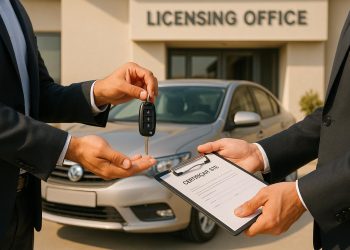Transferring car ownership in South Africa in 2025 can be straightforward if you follow the updated process and meet all requirements. Here’s a quick breakdown:
- Key steps: Submit the Notification of Change of Ownership (NCO) form, ensure the vehicle has a valid roadworthy certificate, and complete the Application for Registration and Licensing of Motor Vehicle (RLV/MVR1A) form.
- Deadlines: The process must be completed within 21 days of the sale to avoid penalties.
- Required documents: Vehicle registration certificate, roadworthy certificate, IDs, proof of residence, and relevant forms.
- Fees: Transfer and licensing fees vary by location and vehicle type. Late submissions or unpaid fines can result in additional costs.
- Common issues: Missing documents, unpaid fines, or failed roadworthy inspections can delay the process.
Pro tip: Double-check all paperwork and clear any fines before starting. Both the buyer and seller have specific roles, so communication is key. Follow these steps to ensure a smooth transfer and stay compliant with 2025 regulations.
Documents Needed for Car Ownership Transfer
Make sure you have all the necessary paperwork ready before heading to the licensing office to avoid any unnecessary delays.
Required Documents for Sellers and Buyers
Both the seller and buyer must provide original documents to complete the transfer legally. Here’s what you’ll need:
- Vehicle Registration Certificate: This confirms the current ownership of the car.
- Roadworthy Certificate: Ensure this is valid and within the required timeframe.
- Identity Documents: Both parties must bring original IDs or passports. Non-citizens should also include a valid work or residence permit.
- Proof of Residence: A recent document showing your current address is required.
- Forms: Complete and sign the Notification of Change of Ownership (NCO) form and the Application for Registration and Licensing of Motor Vehicle form (commonly referred to as RLV or MVR1A).
Accuracy is crucial when filling out these forms, so double-check all details before submission.
Extra Requirements for Special Cases
Certain situations may call for additional documentation. For example, if the vehicle is:
- Financed through a bank or financial institution.
- Owned by a company.
- Part of an estate transaction.
- Registered under a foreign national’s name.
If any of these apply, it’s a good idea to contact your local licensing office for specific guidance to ensure you meet all requirements.
Where to Get Forms and Information
You can find the required forms on the eNaTIS website or at your local licensing office. Visit www.natis.gov.za under the "Road Traffic related forms" section to download PDFs, which can be filled out electronically before printing.
The eNaTIS public information site also provides FAQs and contact details for service centers across the country. This is a helpful resource, especially if your transfer involves a more complex situation.
How to Transfer Car Ownership: Step-by-Step Guide
Transferring car ownership involves paying close attention to deadlines and details. Make sure to complete the process within 21 days of the sale date to avoid complications.
Step 1: Gather and Verify All Documents
Start by collecting all the necessary documents. This includes the roadworthy certificate, consent letters for financed vehicles, and the vehicle’s registration certificate. Double-check that everything is accurate and up to date.
If you’re buying a car from someone in another province, confirm that your local licensing office accepts the provided documents. Some offices have specific rules for out-of-province transfers, which could impact your timeline if not addressed.
Step 2: Complete and Submit the NCO Form
The seller must fill out and submit the Notification of Change of Ownership (NCO) form within 21 days of the sale. Make sure the form is completed in full, with "N/A" marked in any non-applicable fields. Both the buyer and seller need to sign the form in front of a licensing official or commissioner of oaths.
The seller can submit the NCO form at any licensing office, not just the one where the car was originally registered. Keep the receipt as proof that the seller has met their legal obligations.
Timing is crucial here: Once the NCO form is submitted, the buyer assumes responsibility for the vehicle. This includes traffic fines or any other issues tied to the car.
Step 3: Submit the RLV Form and Pay the Fees
This step is the buyer’s responsibility. Complete the Application for Registration and Licensing of Motor Vehicle form (RLV/MVR1A) and bring it, along with all required documents, to the licensing office.
Plan your visit during non-peak hours to avoid long waits. Also, confirm the accepted payment methods, as these can vary by location.
The licensing official will carefully review your documents to ensure everything is in order. They’ll check the roadworthy certificate, verify your identity, and confirm that all forms are properly filled out. Mistakes or missing information can delay the process, so ensure everything is accurate before submission.
Once your documents are approved, you’ll need to pay the required fees. These typically include transfer, licensing, and registration fees. Always request a receipt for each payment, as it could be useful if any issues arise later. After payment and verification, you’ll be ready to collect your new registration.
Step 4: Receive Your New Registration Certificate and License Disc
After your application and payment are processed, the licensing office will issue your new registration certificate and license disc. If everything is in order, this usually happens on the same day, provided you’re there during normal business hours.
Before leaving the licensing office, carefully review your new registration certificate. Make sure your name, address, and vehicle details are correct. Fixing errors later can be time-consuming and may require repeating parts of the process.
The new license disc must be displayed on your car’s windscreen immediately. Remove the old disc to avoid any confusion during traffic stops or inspections. Store the new registration certificate in a secure place, as it will be needed for future transactions, insurance claims, or if you decide to sell the vehicle.
Keep both physical and digital copies of all receipts and documents. These serve as proof that the transfer was completed correctly and can help resolve any disputes about ownership down the line.
Car Ownership Transfer Fees and Costs in 2025
The fees for transferring car ownership can differ based on your location and the type of vehicle. On top of the standard charges, you might face extra costs if certain regulations aren’t followed. Here’s a breakdown of the additional expenses and penalties to watch out for.
Extra Costs and Penalties
- Late License Renewals: If you miss renewing your vehicle’s annual license within the 21-day grace period after its expiration, you’ll face a penalty. This penalty is 10% of the annual licensing fee for each month the renewal is overdue.
- Unpaid Fines: Outstanding fines can be handed over to a debt collection agency, which adds extra fees to your balance. These unresolved fines can also result in an Administrative Block in the NaTIS system. This block will stop you from completing any vehicle registration or licensing tasks until the fines are cleared.
- Expired License Disc or Unpaid Fines: Driving with an expired license disc or ignoring unpaid fines can lead to your vehicle being impounded. This not only results in additional costs but can also escalate to legal consequences. Persistent non-payment might lead to court appearances, further penalties, mandatory community service, or even imprisonment.
Staying on top of your renewals and fines is not just about avoiding extra fees – it’s about steering clear of legal headaches as well.
sbb-itb-09752ea
Common Problems and How to Fix Them
Even with the best preparation, transferring car ownership can hit a few bumps along the way. Knowing the typical issues and how to resolve them can save you time, money, and a lot of frustration. Here’s a breakdown of the most common problems and practical ways to address them.
Missing or Incorrect Documents
One of the most frequent causes of delays is incomplete or incorrect paperwork. The licensing office won’t process your application if any required document is missing, expired, or contains errors.
To avoid this, start with a detailed checklist of all necessary documents. Before heading to the licensing office, double-check that every form is filled out correctly. Even small mistakes, like a typo on the NCO form, can cause setbacks.
If you’re missing documents – like the seller’s ID or proof of address – get replacements from the relevant authority as soon as possible. Lost or damaged vehicle registration certificates can also be a problem. If the original certificate is illegible or missing, you’ll need to apply for a duplicate, which can take extra time and involve additional fees. Also, make sure your roadworthy certificate is valid; an expired certificate means you’ll need to redo the vehicle inspection.
Lastly, don’t overlook outstanding fines, as they can bring the process to a halt.
Delays from Unpaid Fines or Fees
Unresolved traffic fines are another common roadblock. The NaTIS system flags unpaid fines connected to the vehicle or either party involved, preventing the transfer from moving forward.
To avoid this, both the buyer and seller should check for outstanding fines before starting the process. You can do this through your local traffic department or an online portal. Common issues include parking tickets, speeding fines, or administrative penalties.
Clear any fines well in advance, as system updates can take time. Unpaid e-toll charges or other fees might also require extra documentation to resolve. Always keep your payment receipts handy in case manual verification is needed.
Once fines and fees are sorted, you’ll be one step closer to completing the transfer. But don’t forget about the roadworthy inspection.
Roadworthy Certificate Issues
A failed roadworthy inspection can be a major headache, often requiring repairs before the transfer can proceed. Common reasons for failure include problems with lights, tires, brakes, or emissions.
If your vehicle doesn’t pass, the testing station will usually provide a detailed report outlining the issues. Address each problem thoroughly to avoid needing another inspection.
Choosing the right testing station can make a big difference. Ask local mechanics for recommendations on stations known for clear communication and fair inspections. Timing is also important – schedule the inspection after gathering all other required documents so the certificate stays valid throughout the process.
If re-inspection is necessary, check the station’s policy. Some offer discounted rates for follow-ups within a certain timeframe, while others charge the full fee again. For older vehicles, consider a pre-inspection by a mechanic to catch potential issues early and avoid multiple trips to the testing station.
Conclusion: How to Complete a Smooth Ownership Transfer
Transferring car ownership in South Africa doesn’t have to be a hassle if you’re prepared. Taking the time to get everything in order can save you from unnecessary delays and penalties.
Start by collecting all the required documents. Both the buyer and seller need valid identification, proof of address, and a current roadworthy certificate. Double-check every form for accuracy, as even small mistakes can slow down the process. This attention to detail is key to keeping things on track.
It’s also important to agree on who will cover the fees before moving forward. Standard transfer fees, licensing costs, and possible penalties for missed deadlines should all be budgeted for in advance. Once you’ve sorted out the financial responsibilities, stick to the timeline – especially the 21-day deadline from the sale date. Missing it can lead to penalties that grow over time, so acting quickly is crucial.
Make sure any outstanding fines are cleared, and ensure the roadworthy certificate is valid. Completing all the paperwork properly and on time will help you avoid the common pitfalls that often delay the process.
Don’t forget about car insurance during the transfer. Sellers should notify their insurance provider once the transfer is finalized, while buyers need to arrange new coverage in their name right away. This avoids unnecessary charges and ensures there are no gaps in coverage or unexpected liabilities.
The entire process is designed to protect both parties and ensure the vehicle’s ownership history remains clear and legally compliant. By following these steps, you’ll avoid legal issues and keep everything above board.
With the right preparation, attention to detail, and commitment to deadlines, you can complete the transfer smoothly and maintain a clean ownership record.
FAQs
What happens if I don’t transfer car ownership within 21 days?
If you miss the 21-day deadline for transferring car ownership, you could be hit with penalties and fines for late registration. On top of that, the seller might still be legally tied to the vehicle, leaving them on the hook for unpaid debts, traffic tickets, or other violations linked to the car. To steer clear of these headaches, make sure to complete the transfer quickly and submit all the necessary paperwork on time.
How can I find out if there are any fines or issues that could delay my car ownership transfer?
Before transferring car ownership, it’s important to check for any unpaid fines or issues tied to the vehicle or your driving record. You can do this by accessing official online traffic service platforms or visiting your local vehicle registration office. Clearing up any pending matters ahead of time will help make the transfer process hassle-free.
What steps should I take if my car doesn’t pass the roadworthy inspection for ownership transfer?
If your car doesn’t pass the roadworthy inspection in South Africa in 2025, the first step is to fix the problems identified during the inspection. This might mean taking care of repairs or performing maintenance to get your vehicle up to the required safety standards.
After completing the necessary work, book a retest at an authorized testing center. Once your car clears the retest, you’ll be issued a roadworthy certificate – an essential document for transferring ownership. It’s a good idea to keep detailed records of all repairs and inspections. This can make the process smoother and help you avoid unnecessary setbacks.
Related posts
- South Africa’s Vehicle Import Tariffs Explained
- How to register a used car in South Africa
- How to Register an Imported Vehicle in South Africa (Step-by-Step)
- SA Car Imports: New Rules You Need to Know in 2025





